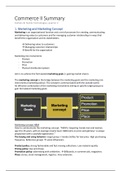Commerce II Summary
Fashion & Textile Technologies, quarter 2
1. Marketing and Marketing Concept
Marketing is an organizational function and a set of processes for creating, communicating,
and delivering value to customers and for managing customer relationships in ways that
benefit the organization and its stakeholders.
→ Delivering value to customers
→ Managing customer relationships
→ Benefit for the organization
Marketing mix instruments:
- Product
- Promotion
- Price
- Physical distribution (place)
Aim is to achieve the formulated marketing goals (= gaining market share).
The marketing concept is the bridge between the marketing goals and the marketing mix
instruments (marketing policy). The concept is communicated with the outside world.
An effective combination of the marketing instruments aiming at specific target groups to
gain formulated marketing goals.
Marketing concept H&M
How to communicate the marketing concept: “H&M is targeting trendy men and women,
age 0 to 35 years, with an average income level. H&M aims on price and glamour: a unique
proposition with a youthful appearance.”
The buying and using behavior: target group = trendy clothes for low price. High purchasing
frequency. Reference groups → social influencers.
Product policy: strong fashionable and fast-moving collections. Low material quality.
Pricing policy: low and cheap.
Promotion policy: advertising with celebrities. → Billboards, tv commercials, magazines.
Place: stores, stock management, logistics. Very extensive.
,Marketing concept Apple
Empathy: understanding customer needs better than any other company.
Focus: eliminate unimportant opportunities, focus on customer satisfaction and technology.
Impute: aiming for best quality and software.
Product: great products, design, quality.
Price: premium pricing (higher price than direct competitors). Skimming: first high, then low
Promotion: exclusive → online, Apple stores.
Physical distribution: all forms of advertising and promotion support the brand image.
Product oriented: very traditional. Production, availability, capacity, organizing, financing.
After production selling the product. Main goal: increasing revenue. Internal oriented = you
don’t do market research for you market and your customer segment.
Market oriented: used by Apple. Start with market research, then organize & finance. Only
start with organizing/production once you know the needs of your customer. Keeping stock
levels low. Strong marketing policy → believe in power of satisfied customers so the
customer come back and you can create a long-term relation with your customers. Then you
can get feedback and you can evaluate your products and processes.
,Stock: high costs, high risks. So keep a low stock and inventory.
Product mix (design, quality, brand, packaging, accessories, assortment, service, warranty)
Price mix (basic price, recommended price, trade margin, trade rebates, consumer rebates,
paying conditions)
Physical distribution (channel choice, distribution, inventory control, transporting)
Promotion mix (advertising, personal selling, sales promotion, sponsoring, public relations,
direct communication)
Basic price = retail price.
Recommended price = advised price for wholesalers.
Physical distribution is lean = you don’t spend money on additional things. Save costs on
inventory, for example.
Promotion mix
Advertising
Mass Communication: using different types such as press media, cinema, shop and internet.
Personal Selling: using salesmen, representatives, account managers. (B2B)
Sales promotion: all activities aiming for temporarily stimulating extra sales.
Sponsoring: financially supporting an organization/ person which delivers a performance in
exchange of canvassing Commercial Publicity to increase the reputation of an organization
and its brands and to establish goodwill.
Public Relations: activities aiming for maintaining positive contacts with target groups and
stakeholders which are important to an organization.
, Marketing environment
Macro Marketing: all activities controlling the flow of goods and services from producer to
consumer. Role of marketing in our society. Recession, legislation. Can’t influence.
Branch/ sector Marketing: the flow of goods and services within a specific branch or sector.
Suppliers, competitors, media. Can influence to a certain extent.
Micro Marketing: flow of goods and services of a specific organization to its customers. Can
fully influence. Employees, managers, processes, functions, financing marketing.
PEST analysis: (to research market developments and to understand the position, potential
and direction for a business)
Political
Economical
Social
Technological
→ For opportunities and threats.
Political Examples: ecological environmental issues, future legislation, trading policies, wars
and conflict, international pressure groups.
Economical Examples: overseas economies and trends, taxation issues, market and trade
cycles, distribution trends, buying power of consumers, trust in the economy, interest and
exchange rates. How profitable is this country?
Social Examples: cultural influences on business. Lifestyle trends, demographics, consumer
buying patterns, fashion and role models, ethical issues, advertising and publicity.





